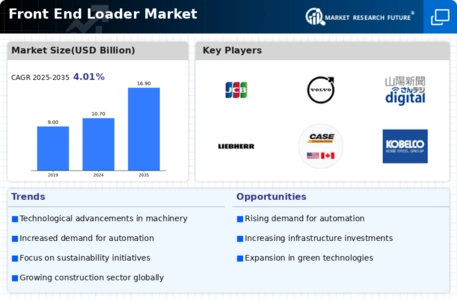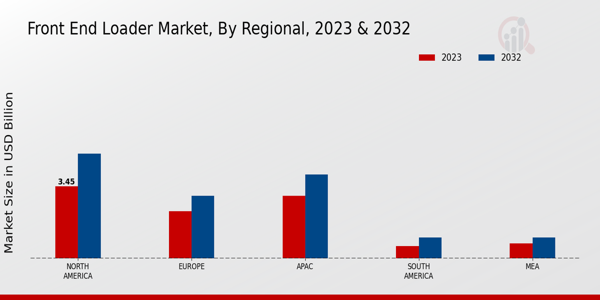Market Growth Projections
The Global Front End Loader Market Industry is poised for substantial growth, with projections indicating a market value of 10.7 USD Billion in 2024 and an anticipated increase to 16.9 USD Billion by 2035. This growth trajectory suggests a compound annual growth rate of 4.2% from 2025 to 2035. Such figures reflect the increasing adoption of front end loaders across various sectors, driven by factors such as infrastructure development, technological advancements, and rising demand in agriculture. The market's expansion is indicative of broader trends in construction and material handling, highlighting the importance of front end loaders in modern operations.
Rising Demand in Agriculture
The Global Front End Loader Market Industry is witnessing a rising demand in the agricultural sector, where these machines are essential for various tasks such as loading, transporting, and handling materials. As global food production needs increase, farmers are increasingly adopting front end loaders to enhance efficiency and productivity on their farms. The versatility of these machines allows them to be used in diverse agricultural applications, from loading feed to moving soil. This trend is likely to contribute to the overall market growth, as the agricultural sector continues to evolve and modernize its operations.
Urbanization and Population Growth
Urbanization and population growth are significant drivers of the Global Front End Loader Market Industry. As more people migrate to urban areas, the demand for housing and infrastructure increases, leading to a higher need for construction equipment, including front end loaders. This trend is particularly evident in developing countries, where rapid urbanization is taking place. The growing population necessitates the expansion of urban infrastructure, which in turn fuels the demand for efficient material handling equipment. Consequently, this dynamic is expected to support the market's growth trajectory in the coming years.
Infrastructure Development Initiatives
The Global Front End Loader Market Industry is experiencing a surge due to increased infrastructure development initiatives worldwide. Governments are investing heavily in construction projects, including roads, bridges, and urban development, which necessitate the use of front end loaders for efficient material handling. For instance, in 2024, the market is projected to reach 10.7 USD Billion, reflecting a growing demand for these machines in various sectors. This trend is expected to continue as countries strive to modernize their infrastructure, potentially leading to a compound annual growth rate of 4.2% from 2025 to 2035. Such investments are likely to bolster the market further.
Technological Advancements in Machinery
Technological advancements play a crucial role in shaping the Global Front End Loader Market Industry. Innovations such as telematics, automation, and improved fuel efficiency are enhancing the performance and productivity of front end loaders. These advancements not only reduce operational costs but also increase safety on job sites. For example, the integration of smart technology allows operators to monitor machine performance in real-time, leading to better decision-making. As these technologies become more prevalent, they are expected to drive market growth, with projections indicating a market value of 16.9 USD Billion by 2035, underscoring the importance of innovation in this sector.
Environmental Regulations and Sustainability
Environmental regulations and sustainability concerns are increasingly influencing the Global Front End Loader Market Industry. As governments worldwide implement stricter emissions standards and promote sustainable practices, manufacturers are compelled to develop eco-friendly front end loaders. These machines are designed to minimize environmental impact while maintaining high performance. The shift towards sustainability is not only a regulatory requirement but also a market demand, as consumers and businesses alike prioritize environmentally responsible equipment. This trend is likely to shape the future of the market, driving innovation and potentially leading to increased market value.






















